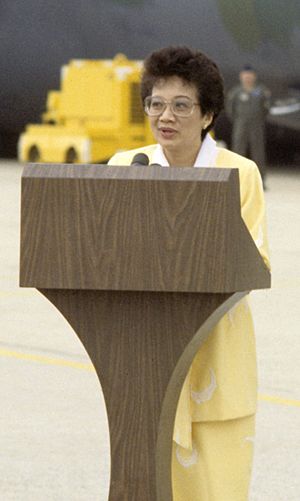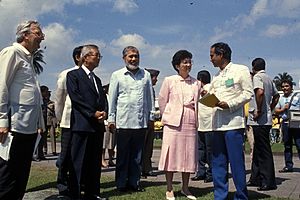Corazon Aquino facts for kids
Quick facts for kids
Corazon C. Aquino
CCLH
|
|
|---|---|

Aquino in 1986
|
|
| 11th President of the Philippines | |
| In office February 25, 1986 – June 30, 1992 |
|
| Prime Minister | Salvador Laurel (Feb.–Mar. 1986) |
| Vice President | Salvador Laurel |
| Preceded by | Ferdinand Marcos |
| Succeeded by | Fidel V. Ramos |
| Personal details | |
| Born |
Maria Corazon Sumulong Cojuangco
January 25, 1933 Paniqui, Tarlac, Philippine Islands |
| Died | August 1, 2009 (aged 76) Makati, Philippines |
| Resting place | Manila Memorial Park – Sucat, Parañaque, Philippines |
| Political party | PDP–Laban (1986–1992) |
| Other political affiliations |
UNIDO (1986–1988) |
| Spouse | |
| Children | 5, including Benigno III and Kris |
| Parent |
|
| Relatives |
|
| Alma mater |
|
| Signature | |
| Nickname | Cory |
Maria Corazon "Cory" Sumulong Cojuangco-Aquino (January 25, 1933 – August 1, 2009) was a Filipino politician. She became the 11th president of the Philippines in 1986. She led the People Power Revolution in 1986. This revolution peacefully ended the long rule of President Ferdinand Marcos. It also brought back democracy to the Philippines.
Corazon Aquino was married to Benigno Aquino Jr., a senator. He was a strong critic of President Marcos. After her husband was assassinated in 1983, she became a leader of the opposition. In 1985, Marcos called for a special election. Aquino ran for president with Salvador Laurel as her running mate. The election in February 1986 was full of fraud. Marcos was declared the winner, but many believed Aquino won. This led to huge protests and the People Power Revolution. This peaceful movement, supported by the military and the Catholic Church, removed Marcos from power. Corazon Aquino became president on February 25, 1986. She had never held an elected office before. She was the first female president of the Philippines.
As president, Aquino helped create the 1987 Constitution. This new constitution limited the president's powers. It also brought back the two-house Congress. Her economic plans focused on improving the country's standing with other nations. She also worked to break up monopolies created during the Marcos era. Her government also started peace talks to end the Moro conflict. This led to the creation of the Autonomous Region in Muslim Mindanao. However, her presidency also saw the Mendiola Massacre, where farmers were killed during a protest.
Towards the end of her term, the Philippines faced natural disasters. These included a big earthquake in 1990 and the eruption of Mount Pinatubo in 1991. Several attempts were made to overthrow her government. She was succeeded by Fidel V. Ramos in 1992. Corazon Aquino was diagnosed with cancer in 2008. She died on August 1, 2009. Her son, Benigno Aquino III, later became president from 2010 to 2016. Corazon Aquino is often called the Mother of Democracy in the Philippines.
Contents
Early Life and Education
María Corazón Sumulong Cojuangco was born on January 25, 1933. Her birthplace was Paniqui, Tarlac. She came from the well-known Cojuangco family. Her father, José Cojuangco, was a businessman and former congressman. Her mother was Demetria Sumulong, a pharmacist. Both her parents came from important political families.
Aquino went to St. Scholastica's College in Manila for elementary school. She was the top student in her class. She then went to Assumption Convent for high school. Later, her family moved to the United States. She finished high school in New York City in 1949. She then went to the College of Mount Saint Vincent in New York. She graduated in 1953 with a degree in French and a minor in mathematics.
After college, she returned to the Philippines. She started studying law at Far Eastern University in 1953. There, she met Benigno "Ninoy" S. Aquino Jr.. She stopped her law studies and married Benigno on October 11, 1954. They had five children: Maria Elena, Aurora Corazon, Benigno Simeon III, Victoria Elisa, and Kristina Bernadette.
Corazon Aquino was a very religious Roman Catholic. She was also fluent in several languages. These included French, Japanese, Spanish, and English. She also spoke her native Tagalog and Kapampangan.
Wife of Benigno Aquino Jr.
Corazon Aquino's husband, Benigno Aquino Jr., became a senator in 1967. For most of his political career, Corazon was a housewife. She raised their children and hosted her husband's political friends. She preferred to stay in the background during his campaigns. She even sold some of her valuable family items to help fund his campaigns.
Benigno Aquino Jr. became a leading critic of President Ferdinand Marcos. Marcos declared martial law in 1972. Benigno Aquino Jr. was one of the first people arrested. He was later sentenced to death. During his time in prison, Corazon Aquino campaigned for him. She gave her first political speech during the 1978 elections.
In 1980, Benigno Aquino Jr. had a heart attack. Marcos allowed him and his family to go to the United States for medical treatment. The family lived in Boston. Corazon Aquino later said these were the happiest years of her family life.
On August 21, 1983, Benigno Aquino Jr. returned to the Philippines alone. He was immediately assassinated at Manila International Airport. The airport was later renamed in his honor. Corazon Aquino returned a few days later. She led her husband's funeral procession, which was attended by over two million people.
1986 Presidential Campaign
After her husband's death, Corazon Aquino became active in protests against the Marcos government. She became a symbol of the opposition. In November 1985, Marcos suddenly announced special elections. These elections were set for February 7, 1986. Many people signed a petition asking Aquino to run for president. On December 3, Aquino officially announced her candidacy. Salvador Laurel became her running mate for vice president.
During the campaign, Marcos criticized Aquino. He said she was inexperienced in public office. He also made sexist remarks, saying she was "just a woman." The election on February 7, 1986, was full of fraud and violence. On February 15, Marcos was declared the winner. However, an independent count showed that Corazon Aquino had won.
Aquino claimed victory and called for a large rally. She also asked people to boycott businesses linked to Marcos. A huge crowd of about two million people attended her rally in Manila. Many groups, including the Catholic Church and the United States Senate, condemned the election results.
Becoming President
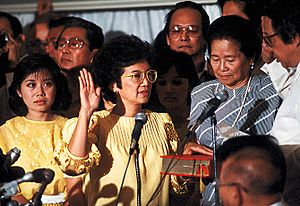
On February 22, 1986, military officers led by Defense Minister Juan Ponce Enrile and General Fidel V. Ramos announced they were leaving the Marcos government. They believed Aquino had won the election. They set up operations in military camps in Quezon City. Cardinal Sin, a Catholic leader, asked the public for support. Millions of Filipinos gathered on Epifanio de los Santos Avenue (EDSA) to support the rebels. Aquino flew back to Manila to prepare for the government takeover.
Aquino was sworn in as the eleventh president of the Philippines on February 25, 1986. An hour later, Marcos held his own inauguration. But later that day, Ferdinand Marcos fled the Philippines.
Presidency
| Presidential styles of Corazon Aquino |
|
|---|---|
 |
|
| Reference style | Her Excellency |
| Spoken style | Your Excellency |
| Alternative style | Madam President |
Corazon Aquino's presidency marked the end of strict rule in the Philippines. She was the first female president of the Philippines. She was also the first president who had never held a political position before. She is seen as the first female president in Asia.
New Government and Constitution
On her first day as president, Aquino announced plans to reorganize the government. She asked all officials appointed by Marcos to resign. On March 25, 1986, she created a temporary government. She removed the 1973 Constitution, which was used during martial law. She then issued a temporary "Freedom Constitution." This allowed her to make laws while a new, more complete constitution was being written.
All 15 members of the Supreme Court resigned. Aquino then appointed new members to restore the court's independence. The Supreme Court later declared her government legitimate.
Aquino appointed 48 members to a commission to write a new constitution. This new Constitution of the Philippines was approved by the people on February 2, 1987. It is still the constitution of the Philippines today. It set up a bill of rights and a government with three branches: executive, legislative, and judicial. It also brought back the two-house Congress. Elections for senators and representatives were held in May 1987.
Important Laws
After the new constitution, Aquino signed two important legal codes. The Family Code of 1987 changed laws about family relations. The Administrative Code of 1987 reorganized the government's executive branch. Another key law was the 1991 Local Government Code. This law gave more power to local governments. It allowed them to collect more taxes and get a bigger share of national money.
Other important economic laws were also passed. These included laws about foreign investments and consumer protection.
Economy and Policies
| Population | |
|---|---|
| 1986 |  56 million 56 million |
| Gross Domestic Product (constant 1985 prices) | |
| 1986 | |
| 1991 | |
| Real GDP growth (% change) | |
| 1986 | |
| 1987 | |
| 1988 | |
| 1989 | |
| 1990 | |
| 1991 | |
| 1992 | |
| Average yearly growth rate, 1986-92 | |
| Per capita income (constant 1985 prices) | |
| 1986 | |
| 1991 | |
| Total exports | |
| 1986 | |
| 1991 | |
| Exchange rates | |
| 1986 | 1 USD = 20.38 Php 1 Php = 0.05 USD |
| 1991 | 1 USD = 27.61 Php 1 Php = 0.04 USD |
The economy grew by 3.4% in Aquino's first year. It continued to grow positively throughout her term. Fighting inflation was a top goal. Prices had risen very high during Marcos's last years. Under Aquino, the average inflation rate was much lower.
Ending Monopolies
One of Aquino's first actions was to try and get back the wealth Marcos had illegally gained. She created the Presidential Commission on Good Government (PCGG) for this task. Marcos had given special business powers to his close friends. This created monopolies in many industries. President Aquino worked to open up the market. She especially focused on the sugar and coconut industries to end these monopolies.
Dealing with Debt
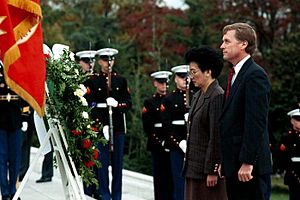
The Philippines had a huge foreign debt from the Marcos years. It grew from less than $3 billion in 1970 to $28 billion by the end of his rule. This debt hurt the country's international reputation. Aquino decided to pay off these debts. This was an unpopular decision for some. But she believed it would improve the country's economic standing. This helped attract foreign investors and get better terms for future loans.
Land Reform
President Aquino wanted to make land reform a main part of her government's social plans. This meant giving agricultural land from large landowners to farmers. In 1988, Congress passed the "Comprehensive Agrarian Reform Law" (CARP). This law allowed for the redistribution of farm lands. Landowners were paid for their land and could only keep a small portion.
However, Aquino faced criticism because her own family owned a large estate called Hacienda Luisita. Instead of distributing the land, the estate became a corporation. It gave shares of stock to farmers instead of land. Critics said this was not true land reform. The stock distribution plan was later changed in 2006. The land was then ordered to be given directly to the farmers.
Challenges During Presidency
Coup Attempts
From 1986 to 1990, there were many attempts to overthrow Aquino's government. These were often led by military groups who wanted a military government. Some attempts were also made by people loyal to former President Marcos.
Mendiola Massacre
On January 22, 1987, a tragic event called the Mendiola Massacre happened. Farmers were protesting peacefully near the Malacañan Palace. They were asking for real land reform. Marines fired at the farmers, killing 12 people and injuring 51. This event led to some officials resigning from Aquino's cabinet.
Peace Talks
President Aquino held peace talks with the Moro National Liberation Front (MNLF). This was an armed Muslim group in Mindanao that wanted an independent state. In 1989, the Autonomous Region in Muslim Mindanao (ARMM) was created. This gave the Muslim-majority areas in Mindanao their own government.
Peace talks also began with communist rebel groups. Aquino ordered the release of many political prisoners from the Marcos era. This included communist leaders. However, peace talks with the communists ended after the Mendiola Massacre.
US Military Bases
After Aquino became president, some senators wanted the U.S. military to leave the Philippines. They felt the bases, like U.S. Naval Base Subic Bay and Clark Air Base, hurt national independence. Aquino initially disagreed. She believed the bases should stay. Many Filipinos also worked at these bases and would lose their jobs if the U.S. left.
The debate was ongoing when Mount Pinatubo erupted in June 1991. The eruption covered the area with volcanic ash. Despite efforts to keep the Subic Base, Aquino eventually agreed to its closure. In December 1991, the U.S. was told to close the base by the end of 1992.
Natural Disasters
The Philippines faced several natural disasters during Aquino's term. In 1987, the MV Doña Paz ferry sank, killing over 4,300 people. This was one of the deadliest maritime disasters of the 20th century.
In 1990, a strong earthquake hit Luzon. It killed about 1,621 people and caused huge damage. In 1991, the eruption of Mount Pinatubo killed around 800 people. It also destroyed farmlands in Central Luzon. About 20,000 people had to leave their homes. Later in 1991, Tropical Storm Thelma caused massive flooding in Ormoc City. It killed about 5,000 people.
Power Shortages
During Aquino's presidency, long power outages became common in Manila. Businesses lost a lot of money because of these blackouts. Aquino had decided to close the Bataan Nuclear Power Plant. This plant was built during the Marcos administration. Critics said it was unsafe. However, closing it contributed to the electricity shortage. Her government did not find a good replacement for the plant before her term ended.
1992 Presidential Election
The 1987 Constitution limited the president to one six-year term. Aquino could not run for re-election. She initially supported Ramon V. Mitra for president in the 1992 Philippine presidential election. But she later changed her mind. She decided to support General Fidel V. Ramos, her defense secretary. Ramos had supported her government during the coup attempts. Her decision surprised many of her supporters. Ramos won the 1992 elections.
On June 30, 1992, Corazon Aquino peacefully handed over power to Fidel Ramos. She left the ceremony in a simple car she bought herself. This showed that she was returning to being an ordinary citizen.
Post-Presidency

After her presidency, Corazon Aquino remained active in Philippine politics. She spoke out against government actions she felt threatened democracy.
In 1997, she opposed President Fidel Ramos's attempt to change the constitution. He wanted to remove term limits for the president. This attempt failed. In 1999, she also opposed a similar plan by President Joseph Estrada.
In 2000, Aquino joined calls for President Estrada to resign. This was due to corruption scandals. Estrada was later removed from office in the Second EDSA Revolution in 2001. Aquino supported Vice President Gloria Macapagal Arroyo becoming president. In 2005, Aquino called for Arroyo to resign due to election rigging allegations.
In 2007, Aquino campaigned for her son, Benigno "Noynoy" Aquino III. He won his senatorial race. After her death, Benigno Aquino III became president in 2010. In 2008, Corazon Aquino expressed regret for her role in Estrada's ouster. She apologized to him. In 2009, she strongly spoke out against Arroyo's plans to change the 1987 Constitution.
International Activities
After her term, Aquino traveled abroad. She gave speeches about democracy, human rights, and women's empowerment. She was a member of the Council of Women World Leaders. This group includes current and former female heads of state. She also supported the release of Burmese democratic leader Aung San Suu Kyi.
Illness and Death
On March 24, 2008, Aquino's family announced she had colorectal cancer. Doctors told her she had only three months to live. She underwent medical treatment and chemotherapy. Many healing Masses were held for her recovery. In July 2009, her condition worsened. Her family decided to stop chemotherapy.
Aquino died in Makati Medical Center on August 1, 2009, at 3:18 a.m. She was 76 years old.
Wake and Funeral

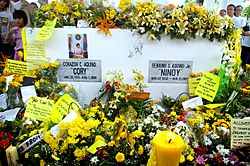
President Gloria Macapagal Arroyo announced a 10-day mourning period. Aquino's children declined the offer of a state funeral. All churches in the Philippines held special masses for her. Government offices flew the Philippine flag at half-mast.
Aquino's body was displayed for public viewing. Hundreds of thousands of Filipinos lined the streets to see her funeral procession. The procession took more than eight hours to reach her burial site. She was buried next to her husband at the Manila Memorial Park in Parañaque. Helicopters dropped yellow confetti, and ships blared their sirens to honor her.
Honors and Legacy
After becoming president, Aquino was named Time magazine's Woman of the Year in 1986. Time also named her one of the 20 Most Influential Asians of the 20th century. In 2006, she was listed as one of 65 great Asian Heroes.
In 1996, she received the J. William Fulbright Prize for International Understanding. In 1998, she received the Ramon Magsaysay Award for her role in bringing democracy peacefully.
Since her death in 2009, many public places have been named after Corazon Aquino.
- On August 1, 2010, a large photo mosaic of Aquino was unveiled in Luneta Park.
- A public market in Manila was named the President Corazon C. Aquino Public Market.
- In 2010, new 500-peso banknotes were released featuring both Corazon and Ninoy Aquino.
- A road in Iloilo City was named President Corazon C. Aquino Avenue.
- The new Corazon C. Aquino Hospital in Dipolog opened in 2015.
- A high school in Quezon City was renamed President Corazon C. Aquino Elementary School.
- A road in Rizal province was renamed Corazon C. Aquino Avenue in 2018.
In 2018, she was recognized as a human rights victim of the Marcos martial law era.
Awards and Achievements
- Philippines
| Philippine Legion of Honor (Chief Commander) | |
| Grand Collar of the Order of Sikatuna |
- Foreign Awards
| Grand Cross of the Order of the Liberator General San Martín (Argentina) | |
| Grand Cross of the National Order of Merit (France) | |
| Order of Merit of the Italian Republic, 1st class (Italy) | |
| Grand Cordon of the Order of the Chrysanthemum (Japan) | |
| Order of Pakistan (Pakistan) | |
| Knight Grand Order of Order of the White Elephant (Thailand) |
- 1986 Time Woman of the Year
- 1986 Eleanor Roosevelt Human Rights Award
- 1986 United Nations Silver Medal
- 1986 Canadian International Prize for Freedom
- 1986 International Democracy Award
- 1987 Prize For Freedom Award
- 1993 Special Peace Award
- 1995 Path to Peace Award
- 1996 J. William Fulbright Prize for International Understanding
- 1998 Ramon Magsaysay Award for International Understanding
- 1998 Pearl S. Buck Award
- 1999 One of Time magazine's 20 Most Influential Asians of the 20th Century
- 2001 World Citizenship Award
- 2005 David Rockefeller Bridging Leadership Awards
- 2005 One of the World's Elite Women Who Make a Difference
- 2006 One of Time magazine's 65 Asian Heroes
- 2008 One of A Different View's 15 Champions of World Democracy
- EWC Asia Pacific Community Building Award
- Women's International Center International Leadership Living Legacy Award
- Martin Luther King, Jr. Nonviolent Peace Prize
- United Nations Development Fund for Women Noel Foundation Life Award
Honorary Doctorates
- Doctor of International Relations, honoris causa, from:
- Boston University
- Eastern University
- Fordham University
- Waseda University
- Doctor of Civil Law, honoris causa, from:
- Doctor of Laws, honoris causa, from:
- University of the Philippines Diliman
- University of Santo Tomas
- University of Hong Kong
- Doctor of Humane Letters, honoris causa, from:
- Ateneo de Manila University
- College of Mount Saint Vincent
- Xavier University – Ateneo de Cagayan
- Doctor of Humanities, honoris causa, from:
- Bicol University (Posthumous)
- San Beda College
- Seattle University
- Stonehill College
- University of Oregon
- Doctor of Public Administration, honoris causa, from:
See also
 In Spanish: Corazón Aquino para niños
In Spanish: Corazón Aquino para niños
- List of Filipino Nobel laureates and nominees


